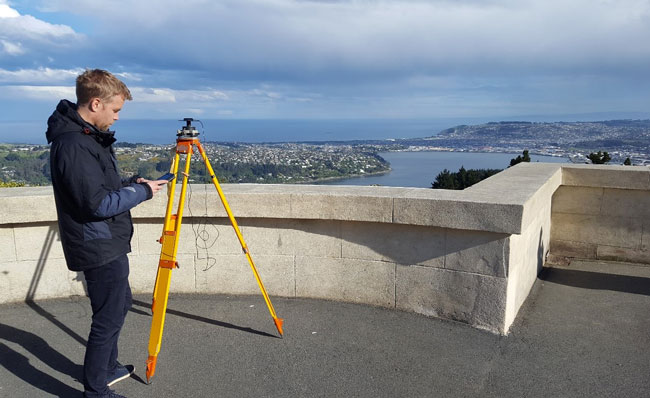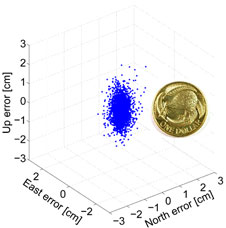
Dr Robert Odolinski, configuring a smartphone to collect multi-GNSS data.
The accuracy of the global positioning system (GPS) in smartphones has been significantly improved thanks to research conducted at the University of Otago, New Zealand, in collaboration with Curtin University, Australia.
Have you ever noticed that the GPS location on your smartphone isn't all that smart? For example, your smartphone claims you are in the duck pond when in fact you are on the other side of the park and can't even see the duck pond? This new research conducted at the University of Otago, and recently published in the international Journal of Geodesy, is about to change that.
By combining signals from four different Global Navigation Satellite Systems (GNSSs), Otago's Dr Robert Odolinski and Curtin University colleague Prof Peter Teunissen, have demonstrated that it is possible to achieve centimeter(cm)-level precise positioning on a smartphone.
“It's all down to the mathematics we applied to make the most of the relatively low-cost technology smartphones use to receive GNSS signals, combining data from American, Chinese, Japanese, and European GNSS. We believe this new capability will revolutionize applications that require cm-level positioning,” Dr Odolinski says.
He says to understand the new technology, a look back at the historical scientific context is needed.

Figure 1. Precise centimetre-level positioning on a smartphone during 24 hours in Dunedin, New Zealand. Blue dots show repeatability of one epoch data in comparison to precise benchmark coordinates. The repeatability is more or less the size of a one dollar New Zealand coin (diameter of 2.3 cm) in all three dimensions.
“For decades, construction, engineering, cadastral surveying and earthquake monitoring have relied on high-cost, 'dual-frequency', GPS positioning to obtain centimetre-level location information. The challenge is that GPS signals, travelling from Earth-orbiting satellites to receivers on the ground, are disrupted along the way, and this generates errors and limiting precision. The traditional solution is to combine GPS signals sent at two different frequencies to improve the positions, but the antennas and receivers required have been expensive, far beyond the reach of many who would benefit from the technology,” says Dr Odolinski.
The new approach uses only one of two frequencies but collects data from more satellites, for what is called a “multi-constellation” GNSS solution. The extra data (and clever maths) is used to improve the positions without adding cost.
What Dr Odolinski and Prof Teunissen have now shown is that this approach can work in smartphones too, producing competitive results compared to dual-frequency GPS solutions (Figure 1).
Dr Odolinski believes that countries and industries of all sizes can benefit from using smartphones as GNSS receivers, and is confident commercial application and development will lead on from this research.
“This significant reduction in costs when using smartphones can increase the number of receivers that can be deployed, which will revolutionize a range of disciplines requiring centimetre-level positioning, including precise car navigation, surveying, and geophysics (deformation monitoring), to name a few.”
Read the full research paper (upon clicking the link an error code may show, however an option to proceed will follow)
For further information, contact:
Dr. Robert Odolinski
School of Surveying
University of Otago
Tel 03 479 5401
Email robert.odolinski@otago.ac.nz
Prof. Peter J. G. Teunissen
Curtin University, Australia
Delft University of Technology, The Netherlands
Email P.Teunissen@curtin.edu.au
Mark Hathaway
Senior Communications Adviser
University of Otago
Mob 021 279 5016
Email mark.hathaway@otago.ac.nz
Electronic addresses (including email accounts, instant messaging services, or telephone accounts) published on this page are for the sole purpose of contact with the individuals concerned, in their capacity as officers, employees or students of the University of Otago, or their respective organisation. Publication of any such electronic address is not to be taken as consent to receive unsolicited commercial electronic messages by the address holder.
FIND an Otago Expert
Use our Media Expertise Database to find an Otago researcher for media comment.